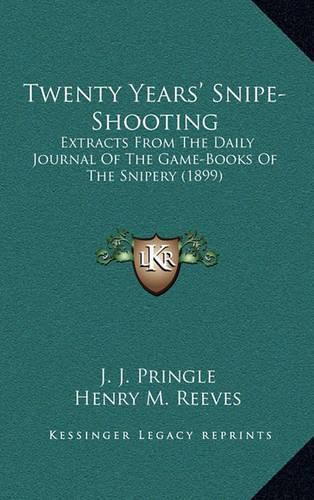Readings Newsletter
Become a Readings Member to make your shopping experience even easier.
Sign in or sign up for free!
You’re not far away from qualifying for FREE standard shipping within Australia
You’ve qualified for FREE standard shipping within Australia
The cart is loading…






Twenty Years’ Snipe Shooting is a detailed, methodical daily account of Pringle’s best days afield during 1867-1887, as extracted from his shooting journals. The practice of recording each day’s hunt was common in Europe but infrequent in North America. Julius Pringle, a wealthy planter, owned Torwood Plantation in Pointe Couple Parish northwest of Baton Rouge, Louisiana. He also had holdings near Franklin, Louisiana such as Ashley, Ironwood, and Camperdown, and a plantation near Georgetown, South Carolina. During his last years of shooting, Pringle noted the decline in snipe numbers. He blamed the loss of habitat as the cause. This is very often the chief reason for a species’ decline, especially in recent times, but in Pringle’s era the snipe was also a victim of overshooting. Today many of Pringle’s shooting fields produce sugarcane rather than snipe. This book is a fascinating account of hunting in the late 1800’s. Illustrated.
$9.00 standard shipping within Australia
FREE standard shipping within Australia for orders over $100.00
Express & International shipping calculated at checkout
Twenty Years’ Snipe Shooting is a detailed, methodical daily account of Pringle’s best days afield during 1867-1887, as extracted from his shooting journals. The practice of recording each day’s hunt was common in Europe but infrequent in North America. Julius Pringle, a wealthy planter, owned Torwood Plantation in Pointe Couple Parish northwest of Baton Rouge, Louisiana. He also had holdings near Franklin, Louisiana such as Ashley, Ironwood, and Camperdown, and a plantation near Georgetown, South Carolina. During his last years of shooting, Pringle noted the decline in snipe numbers. He blamed the loss of habitat as the cause. This is very often the chief reason for a species’ decline, especially in recent times, but in Pringle’s era the snipe was also a victim of overshooting. Today many of Pringle’s shooting fields produce sugarcane rather than snipe. This book is a fascinating account of hunting in the late 1800’s. Illustrated.